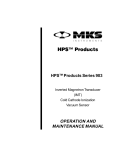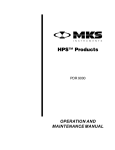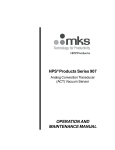Download HPS® Products Series 945 Digital Pirani Vacuum Sensor System
Transcript
HPS® Products Series 945 Digital Pirani Vacuum Sensor System OPERATION AND MAINTENANCE MANUAL HPS® Products Series 945 Digital Pirani Vacuum Sensor System Part #109450020 Rev. B Digital Pirani Vacuum Sensor System Part # 945-X-XXX-XX – __– __ __ __–__ __ Serial # __ __ __ __ __ __ Please fill in these numbers and have them readily available when calling for service or additional information. (The part number can be found on your packing slip, and the serial number is located on the back panel of the controller.) For more information or literature, contact: MKS Instruments, Inc., HPS® Products, Inc. 5330 Sterling Drive Boulder, CO 80301 USA Phone: 303-449-9861 800-345-1967 FAX: 303-442-6880 © 1999 by MKS Instruments, Inc. HPS® Products, Inc., All rights reserved. HPS® is a registered trademark of MKS Instruments, Inc., HPS®Products. Teflon is a registered trademark of DuPont Co. VCR ®is a registered trademark of Swagelok® Company. Digital Pirani Vacuum Sensor System Table of contents Table of contents Package Contents ..................................................................... 1 Symbols Used in this Manual .................................................... 2 Safety Precautions .................................................................... 3 Specifications ............................................................................ 5 Controller ................................................................................................. 5 Sensor Tube ...................................................................................... 6 Feature and Control Locations .................................................. 7 Typical Applications for the Series 945 Pirani System .............. 8 About the SensaVac® Series 945 Pirani Vacuum Sensor System .................................................................................................. 9 Installing the Series 945 Pirani System ................................... 10 Pirani Sensor Installation .......................................................................10 Location ........................................................................................... 10 Orientation ....................................................................................... 10 Contamination .................................................................................. 10 Vacuum Connection ......................................................................... 10 Pirani Controller Installation ....................................................................11 Controller Mounting ..........................................................................11 Connecting the Sensor to the Controller ........................................... 12 AC Power Cord ................................................................................12 Fuse Replacement ........................................................................... 13 Accessory Connector .......................................................................13 Relay Inductive Loads and Arc Suppression ...................................14 Operating the Series 945 Pirani System.................................. 15 Reading Pressure ...................................................................................15 Sensor Adjustment ................................................................................. 16 Calibrating for Zero and Atmosphere ...................................................... 17 Adjusting the Set Point ........................................................................... 17 Venting to Atmosphere ........................................................................... 17 Buffered Analog Output ..........................................................................18 Use with Computers ............................................................................... 18 Leak Detection ....................................................................................... 18 Digital Pirani Vacuum Sensor System Using the Series 945 Pirani System with Other Gases............ 20 Nitrogen Equivalent Pressure ................................................................. 20 Calibrating for Other Gases .................................................................... 21 Maintaining the Series 945 Pirani System ............................... 22 Troubleshooting and Service ................................................................... 22 Cleaning the Pirani Controller Front Panel .............................................. 22 Cleaning the Pirani Sensor ..................................................................... 23 Testing the Pirani Sensor ....................................................................... 23 Accessories ............................................................................. 24 Product Warranty ..................................................................... 25 Notes ....................................................................................... 26 Appendix A: How the Series 945 Pirani System Works .......... A.1 Theory of a Thermal Conductivity Sensor ............................................. A.1 Measurement Limits ............................................................................. A.1 The Series 945 Pirani System Design Overview .................................. A.2 Amplifier ........................................................................................ A.2 Output ............................................................................................ A.2 Set Point Relays ............................................................................ A.2 Comparator .................................................................................... A.2 Digital Pirani Vacuum Sensor System Package Contents Before unpacking your Series 945 Digital Pirani Vacuum Sensor System, check all surfaces of the packing material for shipping damage. Please be sure that your Series 945 Pirani System package contains these items: 1 Series 945 Pirani Controller 1 female, 9-pin, subminiature D (D-sub) Accessory connector 1 power cord 1 Series 945 Digital Pirani Vacuum Sensor System User's Manual. The Series 945 System's Pirani Sensor and its connecting cable are sold separately. Please refer to page 24 for necessary ordering information. If any items are missing from the package, call HPS® Products Customer Service at 1-303-449-9861 or 1-800-345-1967. Inspect the Series 945 Pirani System for visible evidence of damage. If it has been damaged in shipping, notify the carrier immediately. Keep all shipping materials and packaging for claim verification. Do not return the product to HPS® Products. Digital Pirani vacuum Sensor System 1 Symbols Used in this Manual The first two symbols below, located on your Series 945 Controller and/or Sensor, identify critical safety concerns. They are used throughout this manual to further define the safety concerns associated with the product. The last two symbols identify other information in this manual that is essential to highlight or useful in achieving optimal performance from your Series 945 Pirani System. CAUTION: Risk of electrical shock. CAUTION: Refer to manual. Failure to heed message could result in personal injury or serious damage to the equipment or both. Failure to heed message could result in damage to the equipment. Information calling attention to important procedures, practices, or conditions. 2 Digital Pirani vacuum Sensor System Safety Precautions Do not use the Series 945 Pirani System's Sensor with explosive gas mixtures or gases that are combustible in air. If the control circuit fails or an exothermic catalytic reaction occurs at the sensor wire, the wire could ignite the gas mixture. When using the Series 945 Pirani System with gases other than air or nitrogen, avoid overpressure to prevent any possibility of explosion. Since the Sensor is calibrated for air/nitrogen, the measured pressure of another gas will differ from its true pressure. Calibrations diverge widely at higher pressures. Since the different gases are not linearly related, a gas correction factor could lead to hazardous overpressure. Capacitance manometers and mechanical dial gauges are best suited for higher pressures. Refer to page 20 for use with other gases. In a system which is filled from a pressurized source, install a safety relief valve or burst disc to safely limit pressure. Turn off power to the Controller before connecting or disconnecting a cable to the Sensor. Connecting or disconnecting cables while the Controller is on may damage the Sensor. Properly ground the Controller. The Controller is grounded through the conductor of the power cord. If the protective ground connection is lost, all accessible conductive parts may pose a risk of electrical shock. Plug the cord into a properly grounded outlet only. When applying a voltage or current to the ports on the rear of the panel, do not exceed manufacturer's specifications. Electrical shock or Controller damage may result. Allow only qualified technicians to service the Series 945 Pirani System. Users should not remove covers, casings, or plug-in components. Injury may result. Any part replacement or internal adjustments must be performed by a qualified technician only. Digital Pirani vacuum Sensor System 3 The Series 945 Pirani Controller contains lethal voltages within the casing. Avoid danger of electrical shock. Unplug the power cord before opening the casing. To prevent damage to the Series 945 Pirani Controller, use the correct line voltage. Use the Controller with the specified line voltage only. Use a fuse of the correct type, voltage, and current rating. Only qualified personnel should change line voltage or fuse ratings if required. Outside of the U.S., use only a detachable cord set that has conductors with a cross-sectional area equal to or greater than 0.75 mm2. Power cables should have agency approval, for example, VDE, Semko, or SEV. The Series 945 Pirani System and all its accessories must be used as instructed by MKS Instruments, Inc., HPS® Products Inc., to ensure safe operation. Use or modification of the equipment in a manner not consistent with specifications may render the product's inherent protection useless. 4 Digital Pirani vacuum Sensor System Specifications Controller Measuring Range 1.0 x 10-4 to 1.0 x 10+2 Torr 1.0 x 10-1 to 1.0 x 10+5 microns 1.0 x 10-4 to 1.3 x 10+2 mbar 1.0 x 10-2 to 1.3 x 10+4 Pa Useful Set Point Range 2.0 x 10-3 to 9.9 x 10+1 Torr 2.0 to 9.9 x 10+4 microns 2.7 x 10-3 to 1.3 x 10+2 mbar 2.7 x 10-1 to 1.3 x 10+4 Pa Resolution 1% of decade, 10% of decade for pressures less than 10-3 Torr Operating Temperature Range 5° to 40°C (41° to 104°F) Storage Temperature Range -10° to 55°C (14° to 131°F) Operating Humidity 80% maximum (noncondensing) Insulation Coordination Installation (Overvoltage) Category II, Pollution Degree 2 Number of Channels 1 Front Panel Controls 2 nonvolatile, independent relay set points; power on-off switch; zero adjustment; atmospheric adjustment Relay Contact Rating SPDT, 1 A @ 24 VAC/DC, resistive Relay Response 150 msec maximum Power Requirement 90 to 130 VAC, 50/60 Hz or 210 to 250 VAC, 50/60 Hz Power Consumption 9W Output Voltage 0.20 to 3.25 VDC, buffered analog, 1Ω maximum output impedance Fuse Rating, Size T 0.16 A, Ø 5 mm x 20 mm for 90 to 130 VAC; T 0.063 A, Ø 5 mm x 20 mm for 210 to 250 VAC Digital Pirani vacuum Sensor System 5 Display LED with 2 significant digits (1 leading) and 1 signed exponent; red, 3/5"-high, 7-segment digits; LED set point indicators; units shown in either Torr, mbar, Pascal, or microns Electronic Casing Aluminum, anodized Dimensions (W x D x H) 3¾" x 7" x 3¾" (96 mm x 178 mm x 96 mm) Size ¼ DIN Weight 2.2 lb (1.0 kg) Sensor Tube Calibration Gas Air/nitrogen Installation Orientation Any Reproducibility 5% of indicated pressure @ Tconst Materials Exposed to Vacuum SS 304, platinum, alumina ceramic, silver brazing alloy, nickel 200 Internal Volume 0.5 in.3 (8.0 cm3) maximum Operating Temperature Range 0° to 50°C (32° to 122°F) Maximum Bakeout Temperature 50°C (122°F) Diameter 1.3 in. (34 mm) Length 4.4 in. (112 mm) Typical Weight (with KF Flange) 0.5 lb (0.2 kg) Vacuum Connection KF 16 1 /8" NPT-M with ½" compression seal option 8 VCR®-F (½") 11/3" CF (non-rotatable) 2¾" CF (non-rotatable) Ø 15.0 mm x 30.0 mm tubing Ø 18.0 mm x 30.0 mm tubing Design and/or specifications subject to change without notice. 6 Digital Pirani vacuum Sensor System Feature and Control Locations Controller Front View Rear View Side View Sensor 1 z 2 z 3 z 4 z 5 z 6 z 7 z 8 z 9 z 10 z 11 z 12 z 13 z 14 z Digital LED Display Power On-Off Rocker Switch View Set Point Push-buttons Set Point Adjustment Potentiometers LED Set Point Indicators Atmospheric Adjustment Potentiometer Zero Adjustment Potentiometer Power Cord Inlet w/ Fuse Holder Panel Mounting Fastener Holes Female, 9-pin Gauge Port Male, 9-pin Accessory Port Slots (for Optional Mounting Brackets) Male D-SUB Sensor Vacuum Port Digital Pirani vacuum Sensor System 7 Typical Applications for the Series 945 Pirani System Measuring foreline and roughing pressures generated by mechanical vacuum pumps Controlling valves and pumps to automate system pump down using the relay set points Sensing abnormal pressure and taking appropriate security measures using the relay set points Controlling system pressure using the analog output as input to an automatic pressure controller Starting or stopping system processes using the relay set points Measuring pressures of backfilled gases in the range of 10-4 to 10+2 Torr Activating high vacuum sensors at the high end of their operating pressure range 8 Digital Pirani vacuum Sensor System About the SensaVac® Series 945 Pirani Vacuum Sensor System The Series 945 Pirani System, together with its Sensor and connecting cable, provides accurate and reliable data for processes which need pressure measurement from 10 +2 Torr down to 10 -4 Torr. It is low in cost and easy to use. The Pirani Sensor is available with one of several standard fittings for vacuum connection. The Sensor connects to the Controller with a cable that has a female,9-pin D-sub on one end and a male, 9-pin Dsub connector on the other. The Controller easily mounts into a ¼ DIN panel cutout or stands alone. All controls, even the power switch, are conveniently accessed from the front panel, and cable connections are hidden to the rear of the Controller. The Series 945 Pirani Controller is useful either as a small system controller or as a module in more sophisticated pressure control environments. The Controller features two standard relay set points for process applications. The pressure readout is a large, easy-to-read digital display. LEDs indicate the status of relay set points, which are independently adjusted using both a push-button and a potentiometer on the front panel. The analog output and relay contacts are accessible from the Accessory port on the rear panel. The Sensor can be located away from the Controller using a cable as long as 500 feet in length. Digital Pirani vacuum Sensor System 9 Installing the Series 945 Pirani System Pirani Sensor Installation Location Locate the Pirani Sensor where it can measure chamber or manifold pressure. Install it away from pumps and gas sources and where vibration is minimal to give the most representative values. Orientation Since a Pirani Sensor is designed to minimize convection, operating position does not affect accuracy. In a standard Pirani system, the atmospheric pressure reading of a horizontal sensor versus a vertical one differs negligibly due to residual convection. The Sensor is factory calibrated vertically with the vacuum port facing down. Contamination Locate and orient the Pirani Sensor to avoid contamination which would affect the tube's element. For example, if the Sensor is installed directly above a roughing pump, oil vapor could contaminate the tube's filament wire and cause the calibration to shift. Install the Sensor with the vacuum port facing down whenever possible to prevent particulates falling or liquids flowing into it. Using a screen or porous filter at the port is helpful. Try an HPS® seal and centering ring assembly with a screen. Vacuum Connection Standard vacuum interfaces for the Pirani Sensor include: KF 16 flange 8 VCR®-F (½") fitting 11/3" CF flange Ø 15 mm x 30 mm tubing 2 ¾" CF flange Ø 18 mm x 30 mm tubing 1 /8" NPT-M fitting with a ½" compression seal To fit the KF 16 port to a KF 10 port, use an HPS® adaptive centering ring. To fit the Sensor with the 1/8" NPT, do not use the case for tightening. The Sensor’s vacuum tubing has 9/16" hex flats for tightening. Wrap a layer of Teflon® tape on the threads of the tubing, in the direction of installation, to ensure a leak-free seal. Instead of the NPT fitting, you may opt to use the ½" O-ring compression seal against the vacuum tubing above the thread, but the O-ring seal cannot be used for positive pressure applications. 10 Digital Pirani vacuum Sensor System Ensure a solid electrical connection between the Sensor and the grounded vacuum system to shield the tube element from external electromagnetic sources. In applications which the System will be exposed to large voltage fluctuations, install a centering ring with a screen, and then ground the screen and tubing. Pirani Controller Installation Controller Mounting The Series 945 Pirani Controller is designed for either panel mounting or for stand-alone use. Regardless of the method you choose, assure adequate ventilation to the Controller with at least 1 inch left open above and below the perforated panels. An optional hardware kit, shown below, is also available for mounting the Controller into a standard ¼ DIN cutout in a panel up to 3/16-inch thick (see Accessories, p.24). Leave at least 3 inches of clearance behind the Controller to accommodate the connectors and cables. Mount the Controller into the panel by slipping it through the cutout from the front. Slide the panel mounting brackets into the slots on either side of the Controller from the rear, and secure them using the thumbscrews provided. Adhesive backed rubber feet for bench top use are provided with the mounting kit. Remove the adhesive backing from each foot and apply one to each corner of the aluminum bottom surface. Digital Pirani vacuum Sensor System 11 Connecting the Sensor to the Controller A sensor cable with a standard 9-pin D-sub is required for operation but is purchased separately from the Pirani System. The socket has sufficient contact pressure so that strain relief is unnecessary in most applications, but when exerting excessive stress on the cable, use separate strain relief to prevent damage to the Sensor or Controller. Cables are available in standard lengths of 10, 25, 50, and in custom lengths up to 500 feet. Connect the cable to the rear of the Controller at the Gauge port. Tighten the connector jackscrews into the mating screw locks to ensure proper electrical connection and to prevent stress on the connectors. Turn off the Controller before connecting or disconnecting the cable from the Sensor or Controller. However, it is not possible for this preventative feature to always work, so avoid any possible damage by always turning off the Controller before any connections are made. In applications for which special cables are required, i.e., where the connection must be routed through restrictive barriers or through a conduit, customize a cable using the figure shown on the following page. Use a D-sub connector with jackscrews for strain relief in all applications. AC Power Cord The Series 945 Pirani System includes a standard, 120 VAC, 50/60 Hz power cord with a female IEC-320 connector. If the available power source or connection is different, use only a detachable cord set with conductors that have a cross-sectional area equal to or greater than 0.75 mm2. The power cable should be approved by a qualified agency such as VDE, Semko, or SEV. 12 Digital Pirani vacuum Sensor System 4UBE #ONTROLLER #USTOMIZINGASENSORCABLE Fuse Replacement The Series 945 Pirani System has a combined fuse holder and power outlet located on the rear panel of the Controller. Replace the fuse with the following steps. 1. Unplug the power cord from its outlet. 2. Snap out the fuse holder drawer. 3. Replace the fuse(s) with one of the following time-lag fuses: T 0.16 A (Ø 5 mm x 20 mm) – 90 to 130 VAC T 0.063 A (Ø 5 mm x 20 mm) – 210 to 250 VAC. 4. Close and secure the fuse holder drawer. Accessory Connector Relay set point contacts and the analog output voltage can be accessed from the Accessory port on the rear panel of the Controller. A connector kit to mate to the port is provided. The figure and chart on the next page identify the pin functions of the Accessory port. Do not inadvertently short circuit the set point relay terminals to the analog output voltage. Digital Pirani vacuum Sensor System 13 Pin 1 2 3 4 5 6 7 8 9 Description Set point relay 1 - normally closed contact Set point relay 1 - normally open contact Set point relay 2 - common Not used Analog output voltage (+) Set point relay 1 - common Set point relay 2 - normally closed contact Set point relay 2 - normally open contact Analog output voltage (-) 1 5 6 9 9-pin Accessory port Relay Inductive Loads and Arc Suppression If the set point relay is used to switch inductive loads, e.g., solenoids, relays, transformers, etc., the arcing of the relay contacts may interfere with Controller operation or reduce relay contact life. Therefore an arc suppression network, shown schematically below, is recommended. The values of the capacitance C and the resistance R are calculated by the equations, C = I 2/(1 x 107) and R = E/10Ia where, C is in farads R is in ohms I is DC or ACpeak load current in amperes E is DC or ACpeak source voltage in volts a = 1 + (50/E). Note that, Rmin = 0.5 Ω and Cmin = 1.0 x 10-9 F. 14 Digital Pirani vacuum Sensor System E Operating the Series 945 Pirani System Reading Pressure The Sensor must be connected to the Controller before turning on the unit. Turn the power on to display pressure or to operate the set point relays. The table below shows the Series 945 Pirani System’s voltage output as a function of pressure for nitrogen, argon, and helium, and the graph on the next page gives the same information. Since Pirani systems are gas dependent and the Series 945 Pirani System is calibrated for air/nitrogen, it reads in nitrogen equivalent pressure for argon, helium, or any other gas. The table and graph do not give true pressure of gases other than nitrogen. Refer to page 20, Using the Series 945 Pirani System with Other Gases, to determine true pressure. In the measuring range of 1.0 x 10-4 to 1.0 x 10-3 Torr, only one significant digit will be displayed, e.g., 2 -4 . At pressures above 100 Torr, the Series 945 System's upper measuring limit, the display will show. H1 At pressures below 1x10-4 The display should show LO x 10-4 (See page 17). Series 945 Pirani System Output Voltage vs. Pressure Torr 1.0E-04 5.0E-04 1.0E-03 2.5E-03 5.0E-03 7.5E-03 1.0E-02 2.0E-02 3.0E-02 4.0E-02 5.0E-02 6.0E-02 7.0E-02 8.0E-02 9.0E-02 1.0E-01 2.0E-01 3.0E-01 4.0E-01 Pascal 1.3E-02 6.7E-02 1.3E-01 3.3E-01 6.7E-01 1.0E+00 1.3E+00 2.7E+00 4.0E+00 5.3E+00 6.7E+00 8.0E+00 9.3E+00 1.1E+01 1.2E+01 1.3E+01 2.7E+01 4.0E+01 5.3E+01 Voltage Torr Nitrogen Argon Helium 0.211 0.217 0.225 0.246 0.278 0.307 0.333 0.420 0.491 0.552 0.606 0.655 0.700 0.742 0.781 0.818 1.103 1.306 1.464 0.211 0.215 0.220 0.234 0.255 0.275 0.294 0.358 0.411 0.458 0.500 0.539 0.574 0.607 0.638 0.667 0.896 1.060 1.189 0.211 0.217 0.224 0.243 0.273 0.300 0.324 0.407 0.476 0.536 0.589 0.638 0.684 0.726 0.766 0.804 1.112 1.347 1.543 Pascal Voltage Nitrogen 5.0E-01 6.0E-01 7.0E-01 8.0E-01 9.0E-01 1.0E+00 2.0E+00 3.0E+00 4.0E+00 5.0E+00 6.0E+00 7.0E+00 8.0E+00 9.0E+00 1.0E+01 2.5E+01 5.0E+01 5.0E+01 1.0E+02 6.7E+01 8.0E+01 9.3E+01 1.1E+02 1.2E+02 1.3E+02 2.7E+02 4.0E+02 5.3E+02 6.7E+02 8.0E+02 9.3E+02 1.1E+03 1.2E+03 1.3E+03 3.3E+03 6.7E+03 6.7E+03 1.3E+04 Digital Pirani vacuum Sensor System 1.593 1.702 1.796 1.877 1.949 2.013 2.411 2.609 2.729 2.810 2.868 2.911 2.945 2.973 2.995 3.127 3.172 3.172 3.193 Argon 1.295 1.385 1.462 1.530 1.590 1.643 1.976 2.143 2.245 2.313 2.362 2.399 2.428 2.452 2.471 2.583 2.622 2.622 2.638 Helium 1.713 1.865 2.003 2.129 2.246 2.355 3.174 3.723 4.133 4.456 4.718 4.937 5.122 5.282 15 He 4 N2 3 Output Voltage (VDC) Ar 2 1 0 1.00E-04 1.00E-03 1.00E-02 1.00E-01 1.00E+00 Pressure (Torr) When using the graph, remember that the pressure scale is logarithmic, and the voltage scale is linear. Equal increments of distance along the pressure scale do not correspond to equal pressure changes. Sensor Adjustment Series 945 Pirani Controllers and their Sensors are calibrated at HPS®. However, instances in which user-calibration will be required are: After installation on your system, the Controller and Sensor may need to be calibrated as a unit. They are not calibrated as a unit at the factory. From Sensor to Sensor, readings may differ. If the Sensor becomes contaminated with process chemicals or pump oil, the calibration may shift. 16 Digital Pirani vacuum Sensor System 1.00E+01 1.00E+02 Calibrating for Zero and Atmosphere Vacuum and atmosphere adjustment potentiometers are located on the front panel as shown below. The two adjustments can be made independently, but because of some interaction between them, we recommend making the adjustments in the order below. For best results, let the Series 945 Pirani System remain at the calibration pressure for at least 15 minutes before adjusting the potentiometers. 1. To adjust for atmosphere, an accurate, high pressure reference sensor is required. With the reference sensor at a known pressure (e.g., 50 to 90 Torr), adjust the Atm potentiometer on the Series 945 Controller until the display indicates the correct pressure. Atmosphere Adjust 2. To adjust for vacuum, the Pirani Sensor needs to be on a vacuum system pumped down to less than 1.0 x 10-5 Torr. At this pressure, the Series 945 Controller display should read L0 -4 Torr ( L0 -1 for microns, L0 -4 for mbar, or L0 -2 for Pa). If the display shows TL -4 Torr, turn the Vac potentiometer clockwise until L0 -4 Torr is displayed. If the reading is 1 -4 Torr or higher, turn the Vac potentiometer counterclockwise until L0 -4 Torr is displayed. Zero Adjust Adjusting the Set Point To adjust a set point to open or close the relay contact at a particular pressure, press the view button for the desired set point on the front panel. Keeping this button depressed, use a small screwdriver to adjust the corresponding potentiometer until the reading coincides with the desired set point pressure. When an LED is on, the measured pressure is below the set point value, the normally open relay contact is closed, and the normally closed contact is open. When an LED is off, the measured pressure is above the set point value, the normally open relay contact is open, and the normally closed contact is closed. To prevent the relays from turning on at any pressure, adjust the trim pots counter clockwise until nc is displayed. Digital Pirani vacuum Sensor System 17 Venting to Atmosphere The Pirani Sensor senses pressure by measuring heat loss from a heated fine wire. Sudden venting at its port can greatly stress the Sensor physically. To avoid damage to the Sensor, vent the vacuum system to atmosphere before removing it. Buffered Analog Output The Series 945 Pirani Controller's analog output voltage is buffered. The temperature compensated signal from the Sensor is buffered by a unity gain amplifier, then connected to the Accessory port. This signal has an amplitude of approximately 0.2 V in vacuum to 3.25 V at atmosphere and follows the voltage-versus-pressure curve shown on the previous page. Since this signal is not digitally processed, the Series 945 Pirani System is suitable for use in applications in which measurement speed is important. Use with Computers The Series 945 Pirani System is designed to operate in highly automated systems (especially those controlled by digital computers), as well as in manual systems. It is compatible with a wide variety of computers, interfaces, and software. In order to take full advantage of the System’s capabilities, an analog-todigital (A/D) converter should be used with an input voltage span of 0 to 5 V. The A/D conversion rate should be at least 6 Hz (150 msec conversion time). A resolution of 12 bits is needed, corresponding to 1.22 mV per bit. The A/D converter should have a differential input to prevent ground currents from affecting the measurements. Leak Detection Its inherent sensitivity to gas type makes the Series 945 Pirani System useful for detecting leaks, at rates greater than 10-4 std cc/sec of helium, in foreline and roughing systems. It is a useful complement to a mass spectrometer leak detector, which locates smaller leaks. 1) Pump your vacuum system to a base pressure. 2) Slowly and methodically probe with a small amount of gas. Flooding the leak or moving quickly past the leak can confuse the search since system time lags may be significant. 3) Note the pressure reading. The pressure will either rise or fall, depending upon the thermal conductivity of the probe gas relative to the system gas. The largest change in value indicates the probe gas is nearest the leak location. 4) Repeat the test to confirm. 18 Digital Pirani vacuum Sensor System As with any leak testing, many factors can influence the sensitivity of the test. Explained in further detail below, these include chamber volume; system pressure; probe gas; type of vacuum pump; location of the Sensor, leak, and pump; and others such as pumping speed and size of tubing in the system. Minimize the chamber volume to reduce the search area and increase the efficiency of the test. Sensitivity to gas leaks is also pressure dependent due to the complex nature of heat transfer at pressures above 10-1 Torr and the presence of significant radiation and end losses below 10-3 Torr. In general, leak test sensitivity is greater for lower system pressures. The Series 945 Pirani System is sensitive to any leak probe gas lighter or heavier than the system gas, however, for optimal sensitivity, select a probe gas with the largest difference between its molecular weight and that of the system gas. Lighter gases increase thermal energy transfer while heavier gases reduce it. Helium or argon gas is suitable to probe a system pumping air or nitrogen. The type of vacuum pump used can also affect the accuracy of the leak test. For moderate size leaks, pump down the system with a high vacuum pump such as a diffusion or turbo pump if possible (ion and cryo pumps are not recommended). Leak testing can be done with a mechanical pump, however, cyclical variations in pressure may result due to rotation of the vanes. This shows up as a large background noise signal, possibly masking the leak signal. Place the pump away from the suspected leak source and place the Sensor between the leak and the pump to reduce the Sensor response time. Vacuum tubing between the suspected leak and the Pirani Sensor should be as short and wide as possible to shorten the time required for the probe gas to reach the tubing. If the above detection method does not locate a leak, unexpected high pressures may be caused by a virtual leak, i.e., outgassing of a system component. You can locate outgassing parts, or "virtual leaks", as well as true gas leaks, using the rate-of-pressure-rise method. 1) With the Controller on, pump down the system to a base pressure. 2) Isolate the pump by closing a valve. 3) Measure the rise in pressure over a time interval. A very fast rise indicates a leak. 4) Repeat this procedure as often as necessary. Digital Pirani vacuum Sensor System 19 Using the Series 945 Pirani System with Other Gases Before using the Series 945 Pirani System to measure pressure of gases other than air or nitrogen, you should read and understand this section. To answer further questions, contact Applications Engineering at HPSTM Products at 1-303-449-9861 or 1-800-345-1967. The Series 945 Pirani System is designed to give voltage output for air/ nitrogen according to the graph on page 16 or the table on page 15. If the Pirani System is used to read pressure of gases with poorer heat transfer properties than nitrogen, the true system pressure may be much higher than indicated. This reading error could lead to dangerous overpressure. A system which is backfilled from a pressurized gas source should contain a safety device, such as a burst disc. Nitrogen Equivalent Pressure The thermal loss from a heated sensor element is a function of the transporting gas (see page A.1, Theory of a Thermal Conductivity Sensor.) Since the Series 945 Pirani System's Sensor is such a gauge, the voltage output depends upon the gas measured. 1. Locate the indicated pressure on the pressure axis of the graph on page 16 (as shown in the example to the right). Locate the point at which a vertical line from this point intercepts the curve for N2. 2. Locate the point at which a horizontal line from the point on the N2 curve intercepts the He or Ar curve. 3. Locate the point at which a vertical line from the He or Ar curve intercepts the pressure axis. This point corresponds to the true pressure for He or Ar. 20 Digital Pirani vacuum Sensor System Output Voltage (VDC) When used with gases other than nitrogen (N2), the System reads in nitrogen equivalent pressure. For example, when the Sensor is set up to read pressure for N2 but is used with the gases helium (He) or argon (Ar), the data for He and Ar in the graph on page 16 are used to convert nitrogen equivalent pressure to true pressure. 4 He #2 3 N2 #3 Ar 2 1 #1 0 10-4 10-3 10-2 10-1 1 Pressure (Torr) 10+1 10+2 The nitrogen equivalent pressures of some gases can exceed the measuring capabilities of the Series 945 Pirani Controller. For example, a true pressure of 6.0 Torr of helium is equivalent to a nitrogen equivalent pressure of several 1000 Torr. The Series 945 Pirani Controller is not capable of measuring this pressure of helium. Calibrating for Other Gases To determine the voltage/pressure relationship for gases which are not shown in the graph or table, you need to calibrate the Series 945 Pirani System with this gas. This calibration requires a gas-independent sensor, such as a capacitance manometer, to act as a standard. A curve like that of page 16 can then be generated and used as described above. The Series 945 Pirani Controller is not intended to be calibrated for direct pressure readings of gases other than air or nitrogen. The calibration is intended only to match the air/nitrogen curve of the Controller to the characteristic of a particular sensor. Digital Pirani vacuum Sensor System 21 Maintaining the Series 945 Pirani System Troubleshooting and Service The Series 945 Pirani Controller is designed to be maintenance-free under normal operation. If a problem should occur, the following chart lists symptoms, possible causes, and their remedies. With this guide, you should be able to diagnose some problems and correct them. Those which fall outside the scope of this chart are generally not serviceable by the user, and the unit should be returned to HPS® for repair. Cleaning the Pirani Controller Front Panel The front panel of the Pirani Controller is designed to resist many laboratory solvents. The casing can be cleaned with water or alcohol. Do not use acetone on the front panel. Troubleshooting Chart Symptom Pressure readings are too high or too low. No analog output voltage, and no display. No analog output voltage, but set points functional. Possible Cause Remedy 2. Gas other than air is used. 3. Controller incorrectly calibrated. 1. Test and replace if necessary. Refer to page 23. 2. Refer to page 20. 3. Refer to page 17. 1. Power supply turned off. 2. Fuse is blown. 3. Defective PC board. 1. Turn power on. 2. Replace fuse. 3. Return to HPS® for repair. 1. Analog output shorted to ground. 2. Accessory or Gauge connector disconnected. 3. Defective PC board. 1. Check cable connections at Accessory port. 2. Connect cable to its port. 1. Contaminated Sensor. 3. Return to HPS® Products for repair. Set point relay will not operate. Display shows "nc" 22 3. Defective PC board. 1. Check set point. 2. Test and replace if necessary. Refer to page 23. 3. Return to HPS® Products for repair. 1. Cable or sensor hot conheated 2. Fensor filament broken 1. Conneat properly (page 12) 2. Replace sensor (page 23) 1. Set point voltage incorrectly set. 2. Broken or shorted Sensor filament. Digital Pirani vacuum Sensor System Cleaning the Pirani Sensor Roughing pump oils and other fluids condensing or decomposing on the heated filament can contaminate the Sensor. This changes the emissivity of the filament, which in turn can cause the calibration to change, especially at low pressure. It is not advisable to clean the Sensor. Trying to clean it may either deform or break the filament, and the deformed filament would then cause additional error from a shift in the Sensor's output. Replace the Sensor if it becomes contaminated (see Accessories, p.24). Testing the Pirani Sensor This test is for function only. Slight Sensor damage by contamination or rough handling can affect calibration, but the tube may still be functional. The most common cause of Sensor failure is a broken filament (checked from pin 4 to pin 6). This could be due to physical abuse or sudden venting of the Sensor to atmosphere. Test the Sensor with an ohmmeter with less than 5 mA of current. The resistance readings of a normal Series 315/345 Sensor measured at atmospheric pressure and at room temperature (20°C) are shown here. 345 D-sub Pin Numbers 4 to 7 4 to 8 6 to 7 6 to 8 5 to 6 3 to 5 Resistance (Ω) 39 114 31 114 62 345 Digital Pirani vacuum Sensor System 23 Accessories Accessory Connector, 9-pin Part # 100004031 Accessory Connector Shell, 9-pin 100005777 Cables for the Pirani Sensor 10 ft ( 3.0 m) 25 ft ( 7.6 m) 50 ft (15.2 m) 103170006SH 103170007SH 103170008SH Mounting Hardware Kit 100005021 Pirani Sensors KF 16 11/3" CF (Non-rotatable) 2 ¾" CF (Non-rotatable) 8 VCR®-F (½") 1 /8" NPT-M with ½" Compression Seal Option Ø 15 mm x 30 mm Tubing Ø 18 mm x 30 mm Tubing 103450010 103450013 103450014 103450012 103450011 103450016 103450018 Power Cord, 115 VAC 103150001 Series 945 Digital Pirani Vacuum Sensor System User's Manual 109450020 Be sure to have on hand the serial number and flange type when ordering replacement parts. Please call HPS® Products Customer Service Department at 1-303-449-9861 or 1-800-345-1967 to order any of these accessories or to receive catalogs for other HPS® Products. 24 Digital Pirani vacuum Sensor System Product Warranty Extent of the Warranty MKS Instruments, Inc., HPS® Products, Inc., warrants the HPS® Products Series 945 Digital Pirani Vacuum Sensor System and its accessories to be free from defects in materials and workmanship for one (1) year from the date of shipment by HPS® or authorized representative to the original purchaser (PURCHASER). Any product or parts of the product repaired or replaced by HPS® under this warranty are warranted only for the remaining unexpired part of its one (1) year original warranty period. After expiration of the applicable warranty period, the PURCHASER shall be charged HPS® current prices for parts and labor, plus any transportation for any repairs or replacement. ALL EXPRESS AND IMPLIED WARRANTIES, INCLUDING THE IMPLIED WARRANTIES OF MERCHANTABILITY AND FITNESS FOR A PARTICULAR PURPOSE, ARE LIMITED TO THE WARRANTY PERIOD. NO WARRANTIES, EXPRESS OR IMPLIED, WILL APPLY AFTER THIS PERIOD. Warranty Service The obligations of HPS® under this warranty shall be at its option: (1) to repair, replace, or adjust the product so that it meets applicable product specifications published by HPS® or (2) to refund the purchase price. What Is Not Covered The product is subject to above terms only if located in the country of the seller from whom the product was purchased. The above warranties do not apply to: I. Damages or malfunctions due to failure to provide reasonable and necessary maintenance in accordance with HPS® operating instructions. II. Damages or malfunctions due to chemical or electrolytic influences or use of the product in working environments outside the specification. III. Fuses and all expendable items which by their nature or limited lifetime may not function for a year. If such items fail to give reasonable service for a reasonable period of time within the warranty period of the product; they will, at the option of HPS®, be repaired or replaced. IV. Defects or damages caused by modifications and repairs effected by the original PURCHASER or third parties not authorized in the manual. Condition of Returned Products HPS® will not accept for repair, replacement, or credit any product which is asserted to be defective by the PURCHASER, or any product for which paid or unpaid service is desired, if the product is contaminated with potentially corrosive, reactive, harmful, or radioactive materials, gases, or chemicals. When products are used with toxic chemicals, or in an atmosphere that is dangerous to the health of humans, or is environmentally unsafe, it is the responsibility of the PURCHASER to have the product cleaned by an independent agency skilled and approved in the handling and cleaning of contaminated materials before the product will be accepted by HPS® for repair and/or replacement. In the course of implementing this policy, HPS® Customer Service Personnel may inquire of the PURCHASER whether the product has been contaminated with or exposed to potentially corrosive, reactive, harmful, or radioactive materials, gases, or chemicals when the PURCHASER requests a return authorization. Notwithstanding such inquiries, it is the responsibility of the PURCHASER to ensure that no products are returned to HPS® which have been contaminated in the aforementioned manner. Other Rights and Remedies I. These remedies are exclusive. HPS® SHALL NOT BE LIABLE FOR CONSEQUENTIAL DAMAGES, FOR ANTICIPATED OR LOST PROFITS, INCIDENTAL DAMAGES OR LOSS OF TIME, OR OTHER LOSSES INCURRED BY THE PURCHASER OR BY ANY THIRD PARTY IN CONNECTION WITH THE PRODUCT COVERED BY THIS WARRANTY, OR OTHERWISE. Some states do not allow exclusion or limitation of incidental or consequential damage or do not allow the limitation on how long an implied warranty lasts. If such laws apply, the limitations or exclusions expressed herein may not apply to PURCHASER. II. Unless otherwise explicitly agreed in writing, it is understood that these are the only written warranties given by HPS®. Any statements made by any persons, including representatives of HPS®, which are inconsistent or in conflict with the terms of the warranty shall not be binding on HPS® unless reduced to writing and approved by an authorized officer of HPS®. III. This warranty gives PURCHASER specific legal rights, and PURCHASER may also have other rights which vary from state to state. IV. For HPS® products sold outside of the U.S., contact your MKS representative for warranty information and service. Warranty Performance To obtain warranty satisfaction, contact the following: MKS Instruments, Inc., HPS® Products, Inc., 5330 Sterling Drive, Boulder, CO 80301, USA at phone number (303) 449-9861. You may be required to present proof of original purchase. Digital Pirani vacuum Sensor System 25 Notes 26 Digital Pirani vacuum Sensor System Appendix A: How the Series 945 Pirani System Works The Series 945 Pirani System is a heat-loss manometer which infers the pressure of a gas by measuring thermal loss from a heated wire. Theory of a Thermal Conductivity Sensor A hot wire suspended from supports in a partial vacuum loses thermal energy in three ways: gas transport, which is pressure dependent, end loss to the supports, and radiation to surrounding surfaces. Pirani and thermocouple sensors use pressure-dependent gas transport from a hot wire to measure pressure. Because end loss and radiation are constant for a wire at constant temperature, they provide a masking signal which largely determines the low pressure limit of the sensor. Optimizing parameters of the wire length and diameter, thermal emissivity, thermal conductivity, and wire temperature can control end loss and radiation but not eliminate these terms. A Pirani sensor may be operated at constant current, voltage, or resistance (equivalent to temperature) at the sensor wire. The Series 945 Pirani System's Sensor is operated at constant temperature to increase high pressure sensitivity. At constant current or voltage, the wire temperature at high pressure is much less than the temperature value at vacuum, reducing the high pressure sensitivity. Measurement Limits At 10-3 Torr, the sum of end and radiation losses is about 10 times the energy lost to the gas through conduction. This determines the practical lower limit for thermal conductivity sensors. At pressures between 20 to 200 Torr, the gas acts as an insulation layer around the filament, which reduces the sensitivity of a Pirani sensor. At pressures above 200 Torr, only convection currents contribute to energy transport from the filament. Convection currents are extremely sensitive to orientation. However, since the Pirani Sensor for the Series 945 System operates to 100 Torr, it can be installed in any direction. Digital Pairani Vacuum Sensor System A.1 The Series 945 Pirani System Design Overview This section is intended to give the reader an overview of the internal workings of the Series 945 Pirani System. This manual does not provide sufficient detail for advanced levels of troubleshooting. Refer to the block diagram while reading this section. Amplifier The Sensor uses a wire as one arm of a balanced Wheatstone bridge. The bridge amplifier maintains the wire at a constant temperature. Thus, the bridge driving voltage from the amplifier is related to the pressure in the Sensor. Atm Adjust Zero Adjust Buffered Analog Output Bridge Amp A/D Converter This voltage is buffered by an op amp and then fed to the analog output, the Controller's digital display, and the comparator circuit. microcontroller Relay Vref Comparators Output Relay The analog output is driven by an op amp. Although it has a fairly low output impedance, it is best to measure the analog output signal with an instrument having at least 1 MW of input impedance. Set Point Relays A reference voltage and op amp form a precision adjustable reference that is fed to the comparator circuit. A potentiometer can be adjusted to the proper voltage to trigger the set point relay at the desired pressure. Comparator An analog comparator circuit compares the voltage from the buffer amplifier (pressure signal) to the set point. When the pressure signal falls below the adjusted reference voltage, a transistor turns on, which energizes the set point relay. A resistor provides a feedback path around the op amp, which increases the set point voltage by approximately 10 mV. This hysteresis provides stable operation even though some noise may be present on the buffered output signal. A.2 Digital Pairani Vacuum Sensor System Display




















































